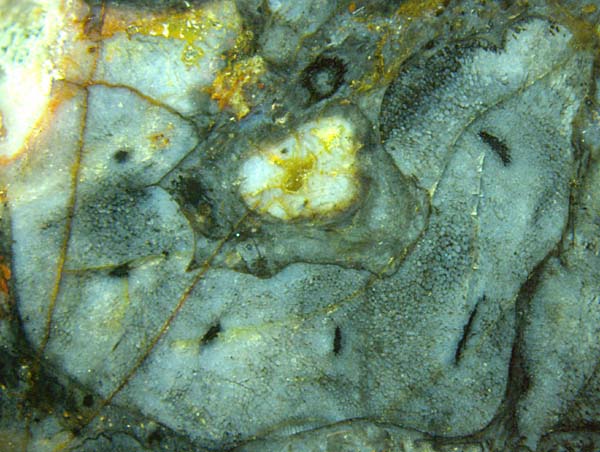Horneophyton
rhizome
In the scientific literature on the early land plants found in the
Lower
Devonian Rhynie chert, Horneophyton
is most often pictured by drawings which had not been drawn
after
fossil evidence but after previous drawings, with slight modifications
for copyright reasons. The repeated re-drawing occasionally produced
grossly disproportionate shapes. Also it
confirmed the impression that structures originally meant to be
schematic illustrations [1] were close to reality. This has concisely
been
laid out, together with related literature, under the heading
"Errors and
mistakes", Part "Poor reconstructions". 
As a well-known fact, Horneophyton
is distinguished by three peculiar features: the odd-shaped sporangia
on top, the branching columella therein, and the perennial tubers in
the ground. Apparently they served the same purpose as the onions of
flowering plants do nowadays, and often have similar shapes,
but unlike onions they do not have a shell structure. Their typical
width is up to 4mm, corresponding to the small size of the plant. Their
mutual arrangement and their possible connectivity are not easily
derived from cut faces.
A drawing in an early publication [2] shows 3 tubers
apparently grown one after another
in a row, the last one bearing the currently alive small stem.
According
to a drawing in [1], several tubers may be
laterally fused in irregular ways, every one with a stem.
Tubers
with stems grown in a straight string had been shown in [3] and
interpreted there as a kind of straight rhizome.
An own sample provides a string of 6 tubers, closely fused in a
horizontal plane such that the shape resembles that of a horseshoe.
With a rhizome like this, the plant would less easily topple on
soft waterlogged ground.
The lateral fusion had gone rather far
here so that the tubers do not appear as individual entities, which
differs remarkably from the aspect of the apparently individual tubers
also found in the Rhynie chert (see Rhynie Chert
News 27). It would be interesting to know
whether or not there is a meaning to the differing mutual
connectivity of the tubers
of this enigmatic plant which apparently lacks any relatives that could
help to find for it a branch on the phylogenetic Tree of Life.
Photograph: Horneophyton
rhizome in Rhynie chert, consisting of 6 tubers fused into a
horseshoe-shaped object, cut nearly horizontally. Width of
the picture 10mm.
H.-J.
Weiss
2015
[1] D.A.
Eggert: The sporangium of Horneophyton lignieri.
Amer. J. Bot. 61(1974), 405-413.
[2] R. Kidston,
W.H. Lang: On Old Red Sandstone plants showing structure,
... Part IV, Trans. Roy. Soc. Edinburgh 52(1921), 831-54.
[3] H.
Hass, H. Kerp:
Rhynie chert plants and their substrates. "The
Rhynie Hot Spring System" Conference, Aberdeen 2003.
 |
 |
79 |




